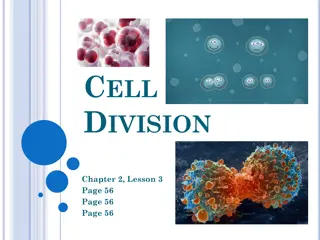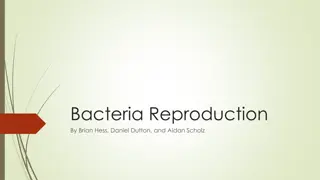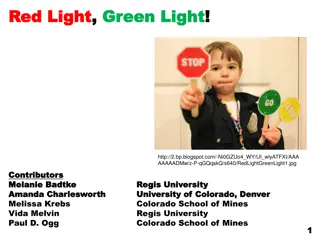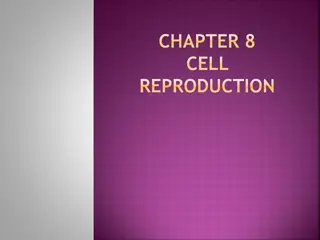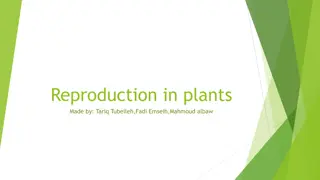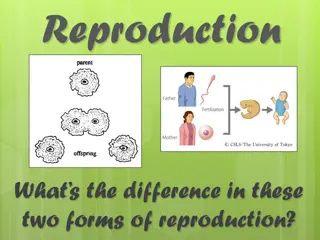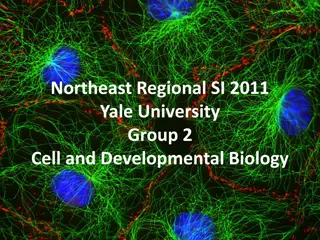Understanding the Cell Cycle: Growth, Division, and Reproduction
The cell cycle is a fundamental process that allows cells to grow, divide, and reproduce, essential for growth, repair, and maintaining the balance of our bodies. It consists of stages like interphase, mitosis, and cytokinesis, each with distinct functions. Interphase is a period of growth and development where cells prepare for division by growing in size, duplicating DNA, and creating necessary structures. Mitosis, the division of the nucleus, results in two identical nuclei, while cytokinesis completes the process by dividing the cytoplasm. Understanding these stages and the roles of DNA, chromosomes, and karyotypes provides insights into the intricate mechanisms that govern cellular life.
Download Presentation

Please find below an Image/Link to download the presentation.
The content on the website is provided AS IS for your information and personal use only. It may not be sold, licensed, or shared on other websites without obtaining consent from the author. Download presentation by click this link. If you encounter any issues during the download, it is possible that the publisher has removed the file from their server.
E N D
Presentation Transcript
Why do cells divide? For growth and repair To get food, water, and waste in and out of our bodies quickly
What is the Cell Cycle? Series of events that take place from one cell division to the next Constantly repeated
Three Stages of the Cell Cycle Interphase Mitosis Cytokinesis
Interphase Period of growth and development Longest phase of the cell cycle Some cells never leave interphase such as nerve and muscle cells
Three things happen during interphase: Cell grows in size; makes an extra set of structures Cell makes a copy of its hereditary material. (DNA) Produces structures needed division (spindle fibers, centrioles)
DNA Deoxyribonucleic acid It is our hereditary material (passed on from our parents) Found in the nucleus of our cells as chromatin
Chromatin vs. Chromosomes Chromatin is uncoiled DNA Chromosomes are tightly coiled strands of DNA
Human Karyotype chromosome
Chromosome #s chromosomes Humans-46 Carrot-18 Cat- 32 Dog-78 Earthworm-36 Fruit fly-8 Chimpanzee-48 Adder s tongue fern-1,262
Mitosis Is the division of the nucleus Results in two new identical nuclei
Four Stages of Mitosis Prophase Metaphase Anaphase Telophase
Prophase Chromatin condenses to form chromosomes. Centrioles move to opposite ends of the cell Spindle fibers form bridge between the ends of the cell. Nuclear envelope breaks down.
Metaphase Chromosomes line up in the center of the cell attaching to spindle fibers by a centromere. metaphase
Anaphase Centromeres split Chromatids separate and become chromosomes. The new chromosomes move to opposite ends of the cell Cell begins to stretch out as the ends are pushed apart.
Telophase Chromosomes stretch out New nuclear envelope forms around each region of chromosomes
Cytokinesis The cell membrane pinches in around the middle of the cell. The cell splits in two Each daughter cell ends up with an identical set of chromosomes and half of the organelles.
Cytokinesis The division of the cytoplasm Usually starts around the same time as telophase Results in two new identical cells (daughter cells) that have the same # of chromosomes as the original parent cell
Cytokinesis in Animal Cells Cell membrane pinches together around the middle of the cell creating two new cells Each daughter cell gets about half of the organelles
Cytokinesis in Plant cells Cell plate forms down the center of the cell The cell plate gradually develops into a cell membrane New cell walls form around the cell membrane
http://www.youtube.com/watch?v=rgLJrvoX_ qo&feature=related




